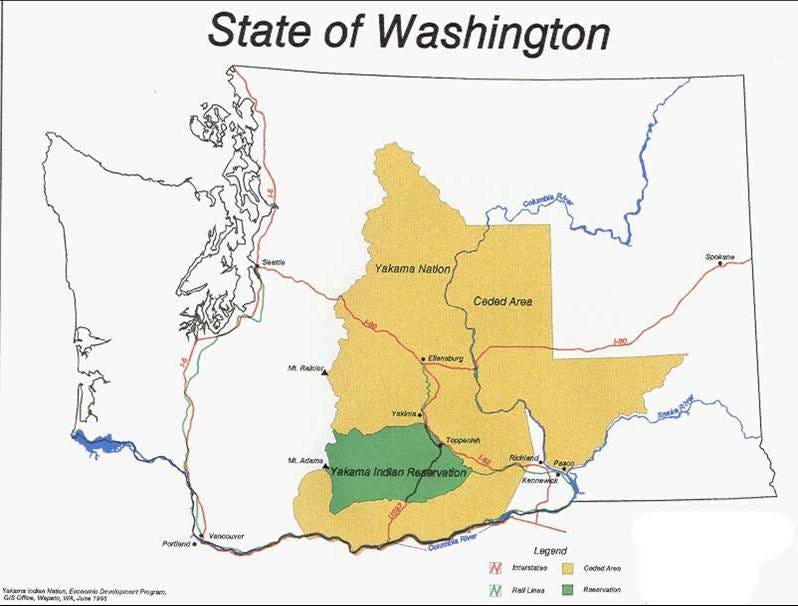A Short History of the Yakama Nation
The struggle for tribal rights and sovereignty isn't just past history- it's today and tomorrow for our Tribal Nations.
OFF TO WORK!
American Airlines Airbus A321 flight from DFW this morning to Seattle, then my connecting Alaska/Horizon Q400 turboprop flight to Yakima. Alaska recently announced they’re retiring the Q400 turboprops next year in the interests of fleet efficiency. No question Horizon’s E175s are a superior passenger experience and standardizing on them makes perfect sense, but I enjoy flying on the Q400s and there’s just something nostalgic about being on an airliner that has propellers.
My flight to Seattle is on N903AA, one of American’s Airbus A321s factory-delivered five years ago from Airbus’s Mobile, Alabama, assembly line.
I’m returning to the Yakama Reservation on this two week duty period, I was last at Yakama IHS in February and it was bitter cold! May is a great time in the Yakima Valley, the weather is just right- not too hot, not too cold. Bitter cold winters and searing hot summers are common east of the Cascades both in Washington and Oregon where we have IHS service units I cover.
Yakama is the busiest Indian Health Service facility in the Pacific Northwest with the biggest population served- the Confederated Tribes and Bands of the Yakama Nation is the largest Native American tribe of the Pacific Northwest.

The official name of the Yakama is the Confederated Tribes and Bands of the Yakama Nation which is made up of 14 tribes: Kah-milt-pah, Klickitat, Klinquit, Kow-was-say-ee, Li-ay-was, Oche-chotes, Palouse, Pisquose, Se-ap-cat, Shyiks, Skin-pah, Wenatshapam, Wish-ham, and Yakama.
The Yakama oral tradition traces their ancestry here on the Columbia Plateau several thousand years back, something supported by archaeological evidence. Though the first non-Natives on Yakama lands were Lewis and Clark during their 1805 expedition, the Yakama had been trading with the Plains Indian tribes and this exposed the Yakama to European diseases that were passed from colonists to the Plains tribes and on to the Yakama via their trade relationship.
Progressive encroachment on Yakama lands eventually resulted in the Treaty of 1855 that established the relationship between the Yakama and the US government. In exchange for keeping their hunting and fishing rights, the Yakama agreed to move to a reservation over the course of two years. However, the Washington governor, Isaac Stevens, opened Yakama lands to settlement just two weeks after the Treaty of 1855 was signed.
This sparked the three year long Yakima Wars (1855-1858) where Chief Kamaikan united the Yakama and allied with a number of other tribes to resist before getting defeated at the Battle of Four Lakes near Spokane. Kamaikan fled to Canada and the remaining Yakama elected a Klickitat, Spencer, to be their new chief. In 1867, Spencer was succeeded by White Swan who served as chief until 1910.
I'd posted before that the late 1800s through most of the 1940s the US government pursued a policy of "Americanizing" the Native Americans and the Yakama had large parts of their culture and traditions eradicated in racist policies. Yakama were rewarded with money and supplies to convert to Christianity and even to cut their hair. By 1900, the Yakama had lost most of their land to the railroads, commercial farming interests and settlers.
This isn't just a matter of interpretation- in light of the recent release of the preliminary report on the Federal Indian Boarding Schools, government records were scrutinized and it is in the federal government's own words in writings and policies going as far back as the administration of Thomas Jefferson that there was a systematic move to both eradicate tribal customs and traditions and dispossess the Tribal Nations of their land.
A series of court cases from 1900 all the way to 1974 allowed the Yakama to regain some of their lost lands which is today's Yakama Reservation. Even as recently as the early 2000s, the Yakama had to go to court to prevent the nuclear waste from being stored on tribal lands from the Hanford nuclear plants to the northeast. Just last summer the Ninth Circuit Court of Appeals upheld the Yakama claim of jurisdiction over lands southwest of Mount Adams called "Tract D".
That's 166 years from the signing of the Treaty of 1855 to the full acknowledgement of the lands promised to the Yakama Nation for their reservation.
We often think of civil rights often in the framework of the African American experience, but there are many other groups that have been systemically disenfranchised by the US government over the years like the Native Americans. They, like the African Americans, struggle for their rights to this day.
What you saw with the Standing Rock Sioux fighting the Dakota Access Pipeline is only the tip of the iceberg in the struggle for tribal rights by our Tribal Nations.
This isn't just history. This is today. And it will be tomorrow as well for Native Americans like the Yakama Nation.
Related posts:




